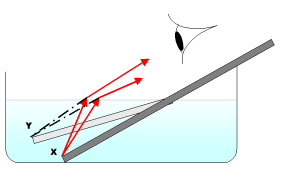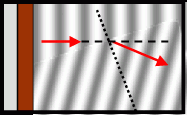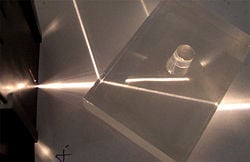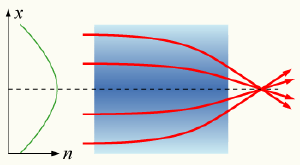Difference between revisions of "Refraction" - New World Encyclopedia
(claimed) |
(→See also: imported text of "Refractive index" from WP) |
||
| Line 31: | Line 31: | ||
In [[medicine]], particularly [[ophthalmology]] and [[optometry]], ''refraction'' (also known as ''refractometry'') is a clinical test in which a [[phoropter]] is used to determine the eye's [[refractive error]] and the best [[corrective lens]]es to be prescribed. A series of test lenses in graded [[optical power]]s or [[focal length]]s are presented to determine which provide the sharpest, clearest vision.<ref>{{cite web|url=http://www.eyeglossary.net/#R|title=Eye Glossary|accessdate=2006-05-23}}</ref> | In [[medicine]], particularly [[ophthalmology]] and [[optometry]], ''refraction'' (also known as ''refractometry'') is a clinical test in which a [[phoropter]] is used to determine the eye's [[refractive error]] and the best [[corrective lens]]es to be prescribed. A series of test lenses in graded [[optical power]]s or [[focal length]]s are presented to determine which provide the sharpest, clearest vision.<ref>{{cite web|url=http://www.eyeglossary.net/#R|title=Eye Glossary|accessdate=2006-05-23}}</ref> | ||
| − | ==See also== | + | == Refractive index == |
| + | |||
| + | The '''refractive index''' (or '''index of [[refraction]]''') of a medium is the inverse ratio of the [[phase velocity]] of a [[wave]] phenomenon such as [[light]] or [[sound]] and the phase velocity in a reference medium. It is most commonly used in the context of [[light]] with [[vacuum]] as a reference medium, although historically other reference media (e.g. [[air]] at a standardized [[pressure]] and [[temperature]]) have been common. It is usually given the symbol ''n''. In the case of light, it equals | ||
| + | |||
| + | :<math> n=\sqrt{\epsilon_r\mu_r}</math>, | ||
| + | |||
| + | where ''ε<sub>r</sub>'' is the material's relative [[permittivity]], and ''μ<sub>r</sub>'' is its relative [[Permeability (electromagnetism)|permeability]]. For most materials, ''μ<sub>r</sub>'' is very close to 1 at optical frequencies, therefore ''n'' is approximately <math>\sqrt{\epsilon_r}</math>. Contrary to a widespread misconception, ''n'' may be less than 1. This has practical technical applications, such as effective mirrors for [[x-rays]] based on [[total internal reflection]]. | ||
| + | |||
| + | The [[phase velocity]] is defined as the rate at which the crests of the [[waveform]] propagate; that is, the rate at which the [[phase (waves)|phase]] of the waveform is moving. The ''[[group velocity]]'' is the rate that the ''envelope'' of the waveform is propagating; that is, the rate of variation of the [[amplitude]] of the waveform. It is the group velocity that (almost always) represents the rate that information (and energy) may be transmitted by the wave, for example the velocity at which a pulse of light travels down an [[optical fiber]]. | ||
| + | |||
| + | ===The speed of light=== | ||
| + | [[Image:Snells law.svg|thumb|[[Refraction]] of light at the interface between two media of different refractive indices, with n<sub>2</sub> > n<sub>1</sub>. Since the velocity is lower in the second medium (v<sub>2</sub> < v<sub>1</sub>), the angle of refraction θ<sub>2</sub> is less than the angle of incidence θ<sub>1</sub>; that is, the ray in the higher-index medium is closer to the normal.]] | ||
| + | |||
| + | The speed of all electromagnetic radiation in vacuum is the same, approximately 3×10<sup>8</sup> meters per second, and is denoted by [[speed of light|''c'']]. | ||
| + | Therefore, if ''v'' is the [[phase velocity]] of radiation of a specific frequency in a specific material, the refractive index is given by | ||
| + | |||
| + | :<math>n =\frac{c}{v}</math>. | ||
| + | |||
| + | This number is typically greater than one: the higher the index of the material, the more the light is slowed down. However, at certain frequencies (e.g. near [[absorption (optics)|absorption]] resonances, and for [[X-ray]]s), ''n'' will actually be smaller than one. This does not contradict the [[theory of relativity]], which holds that no [[Signal (electrical engineering)|information-carrying signal]] can ever propagate faster than ''c'', because the [[phase velocity]] is not the same as the [[group velocity]] or the [[signal velocity]]. | ||
| + | |||
| + | Sometimes, a "group velocity refractive index", usually called the ''group index'' is defined: | ||
| + | |||
| + | :<math>n_g=\frac{c}{v_g}</math> | ||
| + | |||
| + | where ''v<sub>g</sub>'' is the group velocity. This value should not be confused with ''n'', which is always defined with respect to the phase velocity. | ||
| + | |||
| + | At the microscale, an electromagnetic wave's phase velocity is slowed in a material because the [[electric field]] creates a disturbance in the charges of each atom (primarily the [[electron]]s) proportional to the [[permittivity]]. The charges will, in general, oscillate slightly out of [[phase (waves)|phase]] with respect to the driving electric field. The charges thus radiate their own electromagnetic wave that is at the same frequency but with a phase delay. The macroscopic sum of all such contributions in the material is a wave with the same frequency but shorter wavelength than the original, leading to a slowing of the wave's phase velocity. Most of the radiation from oscillating material charges will modify the incoming wave, changing its velocity. However, some net energy will be radiated in other directions (see [[scattering]]). | ||
| + | |||
| + | If the refractive indices of two materials are known for a given frequency, then one can compute the angle by which radiation of that frequency will be [[refraction|refracted]] as it moves from the first into the second material from [[Snell's law]]. | ||
| + | |||
| + | ===Negative Refractive Index=== | ||
| + | |||
| + | Recent research has also demonstrated the existence of [[negative refractive index]] which can occur if ''ε'' and ''μ'' are ''simultaneously'' negative. Not thought to occur naturally, this can be achieved with so called [[metamaterial]]s and offers the possibility of perfect lenses and other exotic phenomena such as a reversal of [[Snell%27s_law|Snell's law]]. [http://www.newscientisttech.com/article/dn10816.html] | ||
| + | |||
| + | ===Dispersion and absorption=== | ||
| + | [[Image:Dispersion-curve.png|right|thumb|320px|The variation of refractive index vs. wavelength for various glasses.]] | ||
| + | |||
| + | In real materials, the [[polarization (electrostatics)|polarization]] does not respond instantaneously to an applied field. This causes [[dielectric loss]], which can be expressed by a [[permittivity]] that is both [[complex number|complex]] and [[frequency]] dependent. Real materials are not perfect [[Electrical insulation|insulator]]s either, i.e. they have non-zero [[direct current]] [[electrical conductivity|conductivity]]. Taking both aspects into consideration, we can define a complex index of refraction: | ||
| + | |||
| + | :<math>\tilde{n}=n-i\kappa</math> | ||
| + | |||
| + | Here, ''n'' is the refractive index indicating the phase velocity as above, while ''κ'' is called the [[extinction coefficient]], which indicates the amount of [[absorption (optics)|absorption]] loss when the electromagnetic wave propagates through the material. Both ''n'' and ''κ'' are dependent on the frequency ([[wavelength]]). | ||
| + | |||
| + | The effect that ''n'' varies with [[frequency]] (except in vacuum, where all frequencies travel at the same speed, ''c'') is known as [[dispersion (optics)|dispersion]], and it is what causes a [[Triangular prism (optics)|prism]] to divide white light into its constituent spectral [[color]]s, explains [[rainbow]]s, and is the cause of [[chromatic aberration]] in [[Lens (optics)|lenses]]. In regions of the spectrum where the material does not absorb, the real part of the refractive index tends to increase with frequency. Near absorption peaks, the curve of the refractive index is a complex form given by the [[Kramers-Kronig relations]], and can decrease with frequency. | ||
| + | |||
| + | Since the refractive index of a material varies with the frequency (and thus wavelength) of light, it is usual to specify the corresponding vacuum wavelength at which the refractive index is measured. Typically, this is done at various well-defined spectral [[emission line]]s; for example, ''n''<sub>D</sub> is the refractive index at the [[Fraunhofer lines|Fraunhofer]] "D" line, the centre of the yellow [[sodium]] double emission at 589.29 [[nanometre|nm]] wavelength. | ||
| + | |||
| + | The [[Sellmeier equation]] is an empirical formula that works well in describing dispersion, and Sellmeier coefficients are often quoted instead of the refractive index in tables. For some representative refractive indices at different wavelengths, see [[list of indices of refraction]]. | ||
| + | |||
| + | As shown above, dielectric loss and non-zero DC conductivity in materials cause absorption. Good dielectric materials such as glass have extremely low DC conductivity, and at low frequencies the dielectric loss is also negligible, resulting in almost no absorption (κ ≈ 0). However, at higher frequencies (such as visible light), dielectric loss may increase absorption significantly, reducing the material's [[transparency (optics)|transparency]] to these frequencies. | ||
| + | |||
| + | The real and imaginary parts of the complex refractive index are related through use of the [[Kramers-Kronig relations]]. For example, one can determine a material's full complex refractive index as a function of wavelength from an absorption spectrum of the material. | ||
| + | |||
| + | ===Anisotropy=== | ||
| + | [[Image:Calcite.jpg|thumb|A calcite crystal laid upon a paper with some letters showing [[birefringence]].]] | ||
| + | |||
| + | The refractive index of certain media may be different depending on the [[polarization]] and direction of propagation of the light through the medium. This is known as [[birefringence]] or anisotropy and is described by the field of [[crystal optics]]. In the most general case, the ''[[dielectric constant]]'' is a rank-2 [[tensor]] (a 3 by 3 matrix), which cannot simply be described by refractive indices except for polarizations along principal axes. | ||
| + | |||
| + | In magneto-optic (gyro-magnetic) and [[optical activity|optically active]] materials, the principal axes are complex (corresponding to elliptical polarizations), and the dielectric tensor is complex-[[Hermitian]] (for lossless media); such materials break time-reversal symmetry and are used e.g. to construct [[Faraday isolator]]s. | ||
| + | |||
| + | ===Nonlinearity=== | ||
| + | |||
| + | The strong [[electric field]] of high intensity light (such as output of a [[laser]]) may cause a medium's refractive index to vary as the light passes through it, giving rise to [[nonlinear optics]]. If the index varies quadratically with the field (linearly with the intensity), it is called the [[Kerr effect|optical Kerr effect]] and causes phenomena such as [[self-focusing]] and [[self phase modulation]]. If the index varies linearly with the field (which is only possible in materials that do not possess [[inversion symmetry]]), it is known as the [[Pockels effect]]. | ||
| + | |||
| + | ===Inhomogeneity=== | ||
| + | [[Image:Grin-lens.png|thumb|A gradient-index lens with a parabolic variation of refractive index (''n'') with radial distance (''x''). The lens focuses light in the same way as a conventional lens.]] | ||
| + | If the refractive index of a medium is not constant, but varies gradually with position, the material is known as a gradient-index medium and is described by [[gradient index optics]]. Light travelling through such a medium can be bent or focussed, and this effect can be exploited to produce [[lens (optics)|lenses]], some [[optical fiber]]s and other devices. Some common [[mirage]]s are caused by a spatially-varying refractive index of [[Earth's atmosphere|air]]. | ||
| + | |||
| + | ===Applications=== | ||
| + | |||
| + | The refractive index of a material is the most important property of any [[optics|optical]] system that uses [[refraction]]. It is used to calculate the focusing power of lenses, and the dispersive power of prisms. | ||
| + | |||
| + | Since refractive index is a fundamental physical property of a substance, it is often used to identify a particular substance, confirm its purity, or measure its concentration. Refractive index is used to measure solids (glasses and gemstones), liquids, and gases. Most commonly it is used to measure the concentration of a [[solute]] in an [[aqueous]] [[solution]]. A [[refractometer]] is the instrument used to measure refractive index. For a solution of sugar, the refractive index can be used to determine the sugar content (see [[Brix]]). | ||
| + | |||
| + | == See also == | ||
| + | |||
* [[List of indices of refraction]] | * [[List of indices of refraction]] | ||
| − | * [[Reflection (physics) | + | * [[Sellmeier equation]] |
| + | * [[Total internal reflection]] | ||
| + | * [[Negative refractive index]] or [[Metamaterial]] | ||
| + | * [[Index-matching material]] | ||
| + | * [[Birefringence]] | ||
| + | * [[Reflection (physics)]] | ||
* [[Willebrord Snellius]] | * [[Willebrord Snellius]] | ||
| − | |||
* [[Total refraction]] | * [[Total refraction]] | ||
* [[Huygens-Fresnel principle]] | * [[Huygens-Fresnel principle]] | ||
| + | |||
| + | ===External links=== | ||
| + | *[http://www.tf.uni-kiel.de/matwis/amat/elmat_en/index.html Dielectric materials] | ||
| + | *[http://scienceworld.wolfram.com/physics/IndexofRefraction.html Science World] | ||
== Footnotes == | == Footnotes == | ||
Revision as of 17:19, 6 February 2007
Refraction is the change in direction of a wave due to a change in its speed. This is most commonly seen when a wave passes from one medium to another. Refraction of light is the most commonly seen example, but any type of wave can refract when it interacts with a medium, for example when sound waves pass from one medium into another.
Explanation
In optics, refraction occurs when light waves travel from a medium with a given refractive index to a medium with another. At the boundary between the media, the wave's phase velocity is altered, it changes direction, and its wavelength increases or decreases but its frequency remains constant. For example, a light ray will refract as it enters and leaves glass; understanding of this concept led to the invention of lenses and the refracting telescope.
Refraction can be seen when looking into a bowl of water. Air has a refractive index of about 1.0003, and water has a refractive index of about 1.33. If a person looks at a straight object, such as a pencil or straw, which is placed at a slant, partially in the water, the object appears to bend at the water's surface. This is due to the bending of light rays as they move from the water to the air. Once the rays reach the eye, the eye traces them back as straight lines (lines of sight). The lines of sight (shown as dashed lines) intersect at a higher position than where the actual rays originated. This causes the pencil to appear higher and the water to appear shallower than it really is. The depth that the water appears to be when viewed from above is known as the apparent depth.
The diagram on the right shows an example of refraction in water waves. Ripples travel from the left and pass over a shallower region inclined at an angle to the wavefront. The waves travel more slowly in the shallower water, so the wavelength decreases and the wave bends at the boundary. The dotted line represents the normal to the boundary. The dashed line represents the original direction of the waves. The phenomenon explains why waves on a shoreline never hit the shoreline at an angle. Whichever direction the waves travel in deep water, they always refract towards the normal as they enter the shallower water near the beach.
Refraction is also responsible for rainbows and for the splitting of white light into a rainbow-spectrum as it passes through a glass prism. Glass has a higher refractive index than air and the different frequencies of light travel at different speeds (dispersion), causing them to be refracted at different angles, so that you can see them. The different frequencies correspond to different colours observed.
While refraction allows for beautiful phenomena such as rainbows it may also produce peculiar optical phenomena, such as mirages and Fata Morgana. These are caused by the change of the refractive index of air with temperature.
Snell's law is used to calculate the degree to which light is refracted when traveling from one medium to another.
Recently some metamaterials have been created which have a negative refractive index. With metamaterials, we can also obtain the total refraction phenomena when the wave impedances of the two media are matched. There is no reflected wave.
Also, since refraction can make objects appear closer than they are, it is responsible for allowing water to magnify objects. First, as light is entering a drop of water, it slows down. If the water's surface is not flat, then the light will be bent into a new path. This round shape will bend the light outwards and as it spreads out, the image you see gets larger.
Ophthalmology
In medicine, particularly ophthalmology and optometry, refraction (also known as refractometry) is a clinical test in which a phoropter is used to determine the eye's refractive error and the best corrective lenses to be prescribed. A series of test lenses in graded optical powers or focal lengths are presented to determine which provide the sharpest, clearest vision.[1]
Refractive index
The refractive index (or index of refraction) of a medium is the inverse ratio of the phase velocity of a wave phenomenon such as light or sound and the phase velocity in a reference medium. It is most commonly used in the context of light with vacuum as a reference medium, although historically other reference media (e.g. air at a standardized pressure and temperature) have been common. It is usually given the symbol n. In the case of light, it equals
- ,
where εr is the material's relative permittivity, and μr is its relative permeability. For most materials, μr is very close to 1 at optical frequencies, therefore n is approximately . Contrary to a widespread misconception, n may be less than 1. This has practical technical applications, such as effective mirrors for x-rays based on total internal reflection.
The phase velocity is defined as the rate at which the crests of the waveform propagate; that is, the rate at which the phase of the waveform is moving. The group velocity is the rate that the envelope of the waveform is propagating; that is, the rate of variation of the amplitude of the waveform. It is the group velocity that (almost always) represents the rate that information (and energy) may be transmitted by the wave, for example the velocity at which a pulse of light travels down an optical fiber.
The speed of light
The speed of all electromagnetic radiation in vacuum is the same, approximately 3×108 meters per second, and is denoted by c. Therefore, if v is the phase velocity of radiation of a specific frequency in a specific material, the refractive index is given by
- .
This number is typically greater than one: the higher the index of the material, the more the light is slowed down. However, at certain frequencies (e.g. near absorption resonances, and for X-rays), n will actually be smaller than one. This does not contradict the theory of relativity, which holds that no information-carrying signal can ever propagate faster than c, because the phase velocity is not the same as the group velocity or the signal velocity.
Sometimes, a "group velocity refractive index", usually called the group index is defined:
where vg is the group velocity. This value should not be confused with n, which is always defined with respect to the phase velocity.
At the microscale, an electromagnetic wave's phase velocity is slowed in a material because the electric field creates a disturbance in the charges of each atom (primarily the electrons) proportional to the permittivity. The charges will, in general, oscillate slightly out of phase with respect to the driving electric field. The charges thus radiate their own electromagnetic wave that is at the same frequency but with a phase delay. The macroscopic sum of all such contributions in the material is a wave with the same frequency but shorter wavelength than the original, leading to a slowing of the wave's phase velocity. Most of the radiation from oscillating material charges will modify the incoming wave, changing its velocity. However, some net energy will be radiated in other directions (see scattering).
If the refractive indices of two materials are known for a given frequency, then one can compute the angle by which radiation of that frequency will be refracted as it moves from the first into the second material from Snell's law.
Negative Refractive Index
Recent research has also demonstrated the existence of negative refractive index which can occur if ε and μ are simultaneously negative. Not thought to occur naturally, this can be achieved with so called metamaterials and offers the possibility of perfect lenses and other exotic phenomena such as a reversal of Snell's law. [1]
Dispersion and absorption
In real materials, the polarization does not respond instantaneously to an applied field. This causes dielectric loss, which can be expressed by a permittivity that is both complex and frequency dependent. Real materials are not perfect insulators either, i.e. they have non-zero direct current conductivity. Taking both aspects into consideration, we can define a complex index of refraction:
Here, n is the refractive index indicating the phase velocity as above, while κ is called the extinction coefficient, which indicates the amount of absorption loss when the electromagnetic wave propagates through the material. Both n and κ are dependent on the frequency (wavelength).
The effect that n varies with frequency (except in vacuum, where all frequencies travel at the same speed, c) is known as dispersion, and it is what causes a prism to divide white light into its constituent spectral colors, explains rainbows, and is the cause of chromatic aberration in lenses. In regions of the spectrum where the material does not absorb, the real part of the refractive index tends to increase with frequency. Near absorption peaks, the curve of the refractive index is a complex form given by the Kramers-Kronig relations, and can decrease with frequency.
Since the refractive index of a material varies with the frequency (and thus wavelength) of light, it is usual to specify the corresponding vacuum wavelength at which the refractive index is measured. Typically, this is done at various well-defined spectral emission lines; for example, nD is the refractive index at the Fraunhofer "D" line, the centre of the yellow sodium double emission at 589.29 nm wavelength.
The Sellmeier equation is an empirical formula that works well in describing dispersion, and Sellmeier coefficients are often quoted instead of the refractive index in tables. For some representative refractive indices at different wavelengths, see list of indices of refraction.
As shown above, dielectric loss and non-zero DC conductivity in materials cause absorption. Good dielectric materials such as glass have extremely low DC conductivity, and at low frequencies the dielectric loss is also negligible, resulting in almost no absorption (κ ≈ 0). However, at higher frequencies (such as visible light), dielectric loss may increase absorption significantly, reducing the material's transparency to these frequencies.
The real and imaginary parts of the complex refractive index are related through use of the Kramers-Kronig relations. For example, one can determine a material's full complex refractive index as a function of wavelength from an absorption spectrum of the material.
Anisotropy
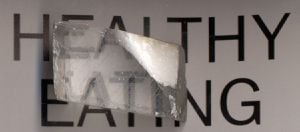
The refractive index of certain media may be different depending on the polarization and direction of propagation of the light through the medium. This is known as birefringence or anisotropy and is described by the field of crystal optics. In the most general case, the dielectric constant is a rank-2 tensor (a 3 by 3 matrix), which cannot simply be described by refractive indices except for polarizations along principal axes.
In magneto-optic (gyro-magnetic) and optically active materials, the principal axes are complex (corresponding to elliptical polarizations), and the dielectric tensor is complex-Hermitian (for lossless media); such materials break time-reversal symmetry and are used e.g. to construct Faraday isolators.
Nonlinearity
The strong electric field of high intensity light (such as output of a laser) may cause a medium's refractive index to vary as the light passes through it, giving rise to nonlinear optics. If the index varies quadratically with the field (linearly with the intensity), it is called the optical Kerr effect and causes phenomena such as self-focusing and self phase modulation. If the index varies linearly with the field (which is only possible in materials that do not possess inversion symmetry), it is known as the Pockels effect.
Inhomogeneity
If the refractive index of a medium is not constant, but varies gradually with position, the material is known as a gradient-index medium and is described by gradient index optics. Light travelling through such a medium can be bent or focussed, and this effect can be exploited to produce lenses, some optical fibers and other devices. Some common mirages are caused by a spatially-varying refractive index of air.
Applications
The refractive index of a material is the most important property of any optical system that uses refraction. It is used to calculate the focusing power of lenses, and the dispersive power of prisms.
Since refractive index is a fundamental physical property of a substance, it is often used to identify a particular substance, confirm its purity, or measure its concentration. Refractive index is used to measure solids (glasses and gemstones), liquids, and gases. Most commonly it is used to measure the concentration of a solute in an aqueous solution. A refractometer is the instrument used to measure refractive index. For a solution of sugar, the refractive index can be used to determine the sugar content (see Brix).
See also
- List of indices of refraction
- Sellmeier equation
- Total internal reflection
- Negative refractive index or Metamaterial
- Index-matching material
- Birefringence
- Reflection (physics)
- Willebrord Snellius
- Total refraction
- Huygens-Fresnel principle
External links
Footnotes
- ↑ Eye Glossary. Retrieved 2006-05-23.
ReferencesISBN links support NWE through referral fees
- David W. Ward and Keith A. Nelson: On the Physical Origins of the Negative Index of Refraction, New Journal of Physics, 7, 213 (2005).
External links
- Java explanatory animation
- Java ilustration of refraction
- Java simulation of refraction through a prism
Credits
New World Encyclopedia writers and editors rewrote and completed the Wikipedia article in accordance with New World Encyclopedia standards. This article abides by terms of the Creative Commons CC-by-sa 3.0 License (CC-by-sa), which may be used and disseminated with proper attribution. Credit is due under the terms of this license that can reference both the New World Encyclopedia contributors and the selfless volunteer contributors of the Wikimedia Foundation. To cite this article click here for a list of acceptable citing formats.The history of earlier contributions by wikipedians is accessible to researchers here:
The history of this article since it was imported to New World Encyclopedia:
Note: Some restrictions may apply to use of individual images which are separately licensed.

